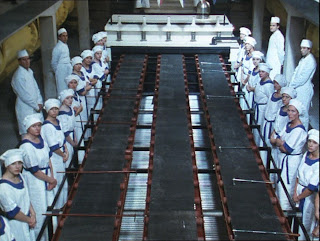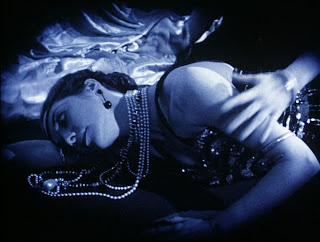© ITV
The
producers have really given me a lot of difficulties with poor Hastings
– a storyline that should have been so simple to work out! Here are the
main problems, all from 1936:
Murder on the Links – May 1936
Murder on the Links
is one of the most essential episodes of the whole series in terms of
chronology. A poster advertising the 1936 Deauville cycling contest is
shown on screen. In addition, a calendar in Giraud’s office shows the
date as “Mercredi 18 Mai” (Wednesday, May 18th). Wednesday, however, was not May 18th
in 1936. The closest fit with the calendar is 1932. But we’ll assume
that the producers wanted the episode to be set in 1936. It is in this
episode that Hastings first meets Bella Duveen (or Dulcie Duveen in the
books).
The Million Dollar Bond Robbery – May 1936
The Queen Mary ( ocean liner) is mentioned. Hastings reads aloud from an article in the Times about the 'maiden voyage', and Poirot and Hastings both join this voyage. Wikipedia says this was May 27th 1936, which gives us a date. But that gives us a problem with Murder on the Links (May 18th 1936) – and Mystery of the Blue Train (May 17th 1936) for that matter. Hastings also fancies one of the culprits, so he can’t possibly have met Bella Duveen yet…
Lord Edgware Dies – June/July 1936
Carlotta Adams’ letter is dated June 29th 1936. Hastings is
supposedly back from the Argentine, having lost the farm in financial
difficulties (stock speculation). Then he can’t have been at Lord
Astwell’s house in The Underdog the same month (June 23rd). Or visited Cambridge in The Case of the Missing Will (June 15th). And
how could he have had time to move to the Argentine in the first place,
when he only met Bella a month earlier? It's all very peculiar.
The ABC Murders – August/September 1936
First of all, Hastings has been with Poirot at the health resort in Evil Under the Sun almost
up until the first letter. Someone on the Agatha Christie 'Have Your
Say' forum has worked out that since the murders takes place between
August 22nd and September 9th, he would only have
had four days to “bag a cayman” in the Amazon and get back again in time
for the first murder. Secondly, Hastings asks Poirot "how have you been
these last six months?", implying that they haven't seen each other for
ages, which is quite frankly impossible, considering that he has been
involved in almost all Poirot's cases in 1936 (even more peculiar, of
course, is the fact that Poirot replies that his grey cells "grow the
rust"! I mean, it's his busiest year ever!).
Yellow Iris – September 1936/1934
The
main story takes place in 1934, during a General Strike in the
Argentine (where did that come from?). There is a coup d’état, and
Poirot is deported back to Britain. Then the story repeats itself “two
years, almost to the day”. This day is probably in spring or early
autumn, but for the sake of chronology, I place it in September. The
reason for Poirot being in the Argentine in the first place is said to
be Hastings: “You will recall, Hastings, that you once asked me to visit
you when you were living in the Argentine? – Yes, two years ago, but
you cancelled in the last minute”. Poirot also explains that he was “due
to travel to las pampas and your ranch”. How can Hastings have a ranch in the Argentine in 1934 – before having met Bella in Murder on the Links?
(I must admit this particular reference error annoys me more than the
others, considering that these two episodes had the same script writer,
Anthony Horowitz, who for those who know his later work, the excellent Foyle's War, is known for historical accuracy).
The Incredible Theft - 1936 (autumn)
The Foreign Secretary, Sir Anthony Eden, is mentioned. He assumed office on 22 December 1935, so the episode will have to be set after that. The episode has a very autumnal feel, which would suggest autumn 1936. However, Hastings is seeing a female student of architecture, so he can't have met Bella yet.
Curtain - 1949
Curtain is set in October 1949 and February 1950. Hastings has a daughter, Judith, who is an adult woman. Since Hastings met Bella in 1936, she can't possibly be older than twelve or thirteen. In other words, Judith has to be given a new backstory...
My solution
1933: The ABC Muders (August)
After
much thought, I've decided that it is absolutely neccesary to ignore
the year of this particular episode (1936). See 1933 and 1936 posts for
more details. The main argument in favour of this solution is a) the
fact that Poirot and Hastings cannot possibly have been apart for almost
the entire year in 1936, and b) there is no way Hastings would have had
the time to go on a four-day holiday to the Amazon between Evil under the Sun
and this case. Also, both the bizarre comment on the six month absence
and the trip to the Amazon would work better in a 1933 setting. Since
Poirot has been retired between July 1932 and May 1933 (see 'Poirot
Timeline'), the fact that they haven't seen each other for six months is
far more likely. Moreover, since I've decided Hastings's interest in
South America is a storyline of its own in the TV series (see The Double Clue, Evil under the Sun),
it would make sense that it is this long holiday that sparks the first
idea of farming in Argentina to become a fixed idea from The Double Clue onwards.
1934: The Double Clue
In
this episode, Poirot meets Countess Rossakoff and is distracted both
from his friends and the investigation. Troubled, Miss Lemon and
Hastings discuss what they’d do if Poirot decided to marry her. Hastings
explains that he has always dreamt of farming in the Argentine (an idea
sparked by his holiday the year before, maybe?). In my chronology, this (sort of) solves the problem of The Yellow Iris;
Hastings puts his dream into action in 1934, going on a long vacation
(Sep-Jan perhaps), renting a farm in the Argentine and inviting Poirot. Like his trip in The ABC Murders, this would also help explain his decision to move to Argentina with Bella later in life - he falls in love with the place.
1936: The Incredible Theft (February/March), The Million Dollar Bond Robbery (May), Murder on the Links (July), Evil Under the Sun (August)
In 1936, Hastings helps Poirot solve 'The Incredible Theft' in February/March. He later goes on the Queen Mary with Poirot and solves the robbery case. I've kept its setting. Murder on the Links
has been moved to July (which also suits the scenery in the episode
better), thus ignoring the calendar in Giraud's office (which is barely
visible on screen). By moving the episode, Hastings can fancy the
culprit in Million Dollar Bond Robbery and join Poirot for his investigations in June.
© ITV
In France, Hastings meets Bella Duveen. The
two of them plan to move to Argentina. This takes a lot of time and
planning, so they don't leave England until January 1937. Within this
period, Hastings even opens an Argentinean restaurant in order to have
enough money to buy the farm (Evil Under the Sun). He also finds
the time to help Poirot out on his cases. I'll ignore the fact that his
restaurant is closed down by the health authorities by the end of Evil Under the Sun
- or at least imagine that Hastings was able to solve the problem and
reopen. We might imagine that he has received financial support from
Poirot as well, and his narratives of Poirot's cases (see 'Poirot
Timeline') may have earned him a decent income.
1937 cont.: Lord Edgware Dies (June)
Hastings
and Bella Duveen have been in Argentina since early in 1937, but
Hastings returns in June, having lost the farm in financial difficulties
(stock speculations). Poirot, who has been in a semi-retirement mode
since he left, is re-establishing himself in Whitehaven (see 'Hercule
Poirot Timeline'). After having solved the Edgware case together with
Poirot, he receives financial support in the form of the Duke of
Merton’s payment for Poirot’s services (see 1937 post). He uses the
money to buy back the restaurant he opened in Evil under the Sun (I imagine he sold it before they left/lost it in the financial difficulties) - or buy back his Argentinean farm -
and moves back to Argentina some time later, having saved up enough
money to buy the farm. This marks the end of his appearances in the
series so far – apart from a holiday with Poirot the year after in Murder in Mesopotamia (we must assume they’ve kept in touch). He reappears in The Big Four, set in 1939, having lived in Argentina in the intervening year(s). After Lord Edgware Dies, he and Bella also adopt an orphaned young girl called Judith. They raise her as their own flesh and blood, and Hastings grows very protective of her. Judith and Hastings help Poirot with his final case, Curtain.
Sigh. That’s the best solution I’ve found. I’ve ignored only three specific references (the month of the calendar in Murder on the Links, the year of Carlotta’s letter in Lord Edgware Dies and the year of the ABC Murders), but I hope you agree that it makes some kind of sense.














































